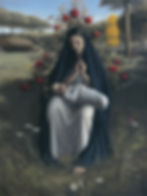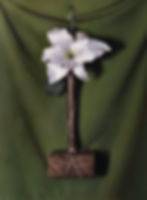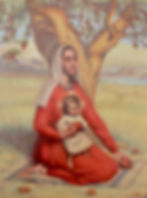top of page
"The Stabat Mater Atelier is a Catholic art school offering a uniquely holistic and faith-based approach to the teaching of artistic practice. Its comprehensive and rigorous training blends the academic method of drawing and painting with traditional compositional theory in a profoundly Christian formation informed by a deep understanding of all Catholic figurative artistic traditions and the importance of the liturgy as the wellspring of all Catholic culture. I wholeheartedly recommend their training for all those whose personal vocation is to be an artist to serve the Church."
David Clayton
Provost, Pontifex University
Artist-in-Residence, Scala Foundation
Sacred Arts Writer, New Liturgical Movement
THE PROGRAM
The Program
Train with World-Class Catholic Artists.
Discover the Design Principles of Sacred Geometry.
Master the Traditional Methods of Drawing and Painting.
Work on real Liturgical Art Projects and Private Commissions.
Be a Part of the 21st Century Renaissance...
Sacred Geometry
The Stabat Mater Studio's Atelier program is truly unique with its attention to sacred geometry. It focuses on visual harmony and universal principles to equip students with the ability to design anything.
Apprenticeship Approach
Taking an apprenticeship-like approach, students gain real-life experience assisting world-class Catholic artists on large liturgical art projects and private commissions.
Skill-based and Faith-based
Almost no higher education art program today actually focuses on the tried and true traditional drawing and painting methods which have been handed down since the Renaissance. Stabat Mater Studio recovers and restores this great skill-based approach, providing the highest quality training to its students. Moreover, the program does so in a manner not hostile to Christianity, but one unabashedly inspired by the Catholic faith and its intellectual and artistic traditions.
Core Curriculum
Our Core Curriculum takes students through an incremental process of mastering the fundamentals of drawing and painting. Core students should expect to work on their projects Monday through Friday 9:00 a.m. - 5 p.m. and work on two courses simultaneously. The academic year is divided into three ten-week trimesters. On average, a student will take three to four years to complete the curriculum.
1. Drawing Essentials
This brief course consists of simple exercises to allow the student to become familiar with his or her drawing tools and best practices.
2. Bargue Drawing Course
“For imitation is natural to man from his infancy. Man differs from other animals particularly in this, that he is imitative, and acquires his rudiments of knowledge in this way; besides, the delight in it is universal.” -Aristotle

Created in the 19th century, the Bargue drawing course was used to teach students how to progress in their proficiency. The drawings are impressively subtle but are also particularly helpful because of the way Bargue interpreted and simplified forms.
3. Simplified Forms Course
“Drawing is the probity of art. To draw does not mean simply to reproduce contours; drawing does not consist merely of line: drawing is also expression, the inner form, the plane, modeling. See what remains after that!” -Jean-Auguste-Dominique Ingres

Before moving on to complex forms as seen in nature it is highly beneficial to study and render the fall of light on geometric shapes. This course takes you through the most common and basic of these forms and gives the student a framework on how to idealize and simplify the forms found in nature.
4. Cast Drawing Course
“He drew from the antique and copied from his predecessors till certain ideals of formal completeness were absolutely fixed in his mind; then when he drew from nature he instinctively subordinated the observed facts to the patterns established in his imagination.” -Kenneth Clark

An established practice in European studios was the drawing of sculptures from antiquity. By removing the difficulty of color, the student works to obtain a mastery of modeling the sense of form on a 2-D surface.
5. Portrait Drawing Course
“The painter must always seek the essence of things, always represent the essential characteristics and emotions of the person he is painting.” -Titian

After learning the process of drawing from a still object, a student progresses on to working from a live model, which poses additional challenges such as simplifying forms and interpreting color into value.
6. Still Life Course
“Beauty is ever present like the light of the sun – even in the most humble object – only it takes an artist’s vision to detect it, and an artist’s skill to reproduce it.” -Emil Carlsen

Still life drawings and paintings are a preliminary study for both landscape painting and multi-figural compositions. In addition, they offer the student the exercise of rendering various shapes and textures. As such, practicing them is immensely helpful for the student's development.
7. The Draped Figure
The human figure has been one of the most important subjects in the Western tradition of art since the Greeks and was reinforced in the Christian tradition in the Renaissance and Baroque styles. Within the human body is a microcosm of the cosmos and a binding together of matter and spirit. No subject is as difficult or rewarding when realized in art.

8. Imaginative Multi-Figure Composition
“The source of genius is imagination alone, the refinement of the senses that sees what others do not see, or sees them differently.” -Eugene Delacroix

Student Options
One of the most challenging tasks for the figurative artist is arranging a unified and believable multi-figural composition in an imagined environment. This course guides the student through this complex task of designing, compiling studies, and executing an original painting.
The Full-Time Student
The full-time student is guided through the core curriculum by taking two courses at a time. In addition, students have full access to the studio and are allowed to take additional evening courses or weekend courses at no additional cost.
Tuition: $2,500 per Trimester
(New students must submit a $500 non-refundable deposit to secure their position.)
The Part-Time Student
The part-time student is guided through the core curriculum building up his or her skill one course at a time. Students receive the same level of attention and instruction as full-time students do. Part-time students are welcome to come in daily to work on their projects for a three-hour session.
Tuition: $1,500 per Trimester
(New students must submit a $500 non-refundable deposit to secure their position. All students must complete their tuition payment by the first day of the trimester.)
Trimester Dates for 2025 -2026
Fall 2025
September 15 - November 21
(Thanksgiving break)
Winter 2025-2026
December 1 - December 19
(Christmas break)
January 12 - February 27
Spring 2026
March 16 - March 27
(Holy Week and Easter break)
April 6 - May 29
Continuing Education
“Painting is a companion with whom one may hope to walk a great part of life’s journey. One by one the more vigorous sports and exacting games fall away, but painting is a friend who makes no undue demands, excites to no exhausting pursuits, keeps faithful pace even with feeble steps, and holds her canvas as a screen between us and the envious eyes of time or the surly advance of decrepitude.” -Winston S. Churchill
The continuing education program allows for a student to go at his or her own pace. While it’s still recommended that a program be followed, students also have the option of choosing their own projects and receiving technical assistance, guidance, and feedback on each.
Tuition
$70 per 2 hour session or $75 per 3 hour session
Instructors
INSTRUCTORS

Robert Puschautz, Executive Director
Robert received his bachelor’s in painting and art education from the University of Illinois Urbana Champaign and continued his studies in classical painting at the Ravenswood Atelier in Chicago. Since moving to Texas he has been creating religious paintings for the Diocese of Tyler and beyond. He is particularly interested in religious subjects, but finds inspiration and metaphor in the created world for still life and landscape paintings.

AnneMarie Johnson, Art Fellow
AnneMarie graduated from the University of Dallas in Irving, Texas, in 2018 with a bachelors in art - painting, and studied in the intensive drawing program at the Florence Academy of Art, US in New Jersey. She completed independent graduate work in painting and art history at the University of Dallas. She recently finished studying under Jordan Sokol and Amaya Gurpide at the Lyme Academy of Fine Arts (Old Lyme, Connecticut), where she was an assistant instructor of drawing. In her body of work, she is particularly drawn to moments when the imperfect and corporeal are pierced by the infinite and transcendent.
Location
STUDIO LOCATION

410 S. Broadway
Tyler, TX 75702
Our newly renovated studio is centered in the flourishing downtown area of Tyler, Texas, across the street from the Cathedral of the Immaculate Conception.
Partners
PARTNERS
Pontifex University
The Stabat Mater Atelier is endorsed by Pontifex University, a Catholic online university offering the unique Master of Sacred Arts, a Catholic inculturation and intellectual formation for artists in any creative pursuit and arts patrons. Pontifex University recommends that students who wish to study artistic practice study at the Stabat Mater Atelier.
Scala Foundation
Stabat Mater Atelier is endorsed by Scala Foundation, a Princeton-based nonprofit whose mission is to transform American culture and the West through beauty in education and the liturgy, and by promoting the commissioning of sacred art and civic art in the public square.
Catholic Art Institute
Stabat Mater Atelier is endorsed by the Catholic Art Institute, a 501(c)(3) nonprofit arts organization working to restore a culture of truth, beauty, and goodness. The CAI empowers artists to use their gifts to glorify God and captivate souls through beauty. It hosts the top scholars, artists, architects, philosophers, and theologians of our day for educational events. Through its speaker series, workshops in traditional art-making techniques, and annual conference, CAI provides preeminent education, resources, and inspiration to all those interested in the elevation of the visual arts.
INSTRUCTOR GALLERY









1/3
bottom of page




